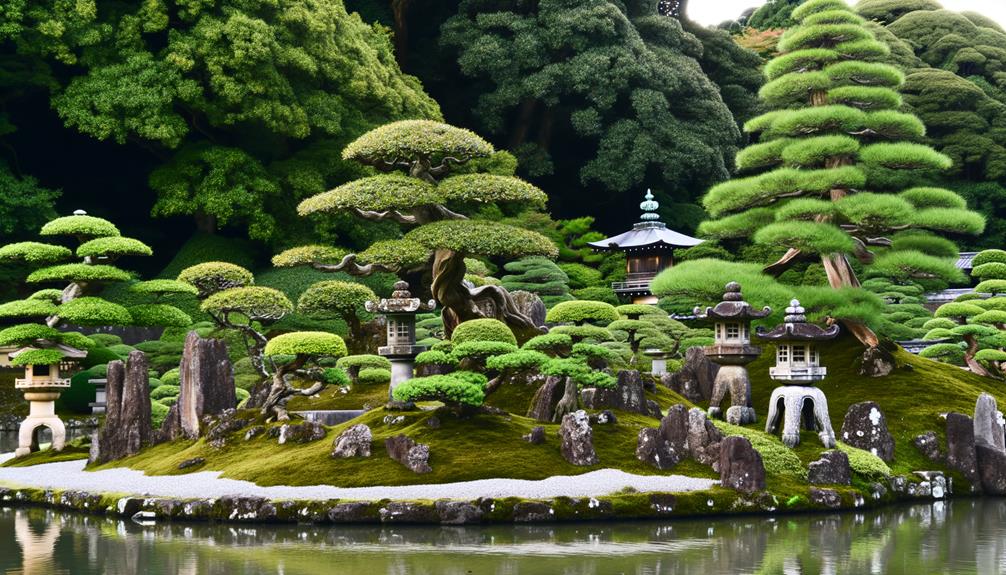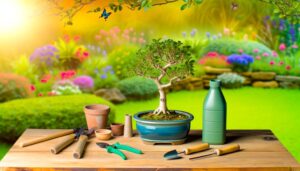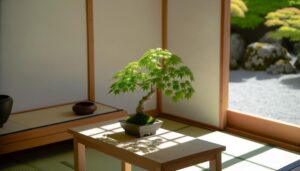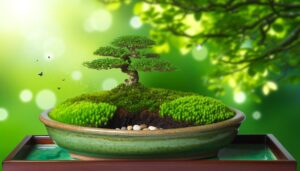Bonsai Trees and Bad Luck: Understanding Cultural Beliefs
Bonsai trees, with their origins in Penjing from the Han Dynasty and refined in Japan, represent a rich tapestry of cultural history and horticultural expertise. In Zen Buddhism, bonsai embodies patience, discipline, and respect for nature, fostering peace and tranquility.
However, some superstitions claim bonsai can restrict growth or disrupt energy flow, rooted in Feng Shui and historical associations. Scientifically, bonsai cultivation involves meticulous techniques, ensuring balanced growth, challenging notions of inherent bad luck.
Emotional bonds and mindfulness practices further dispel these myths. For a deeper understanding of these complex interrelations, enriched by personal experiences and empirical evidence, continue exploring.

Key Takeaways
- Bonsai trees are often considered symbols of harmony, balance, and patience, rather than bad luck.
- Some superstitions suggest bonsai may restrict personal or professional growth, affecting Feng Shui.
- Bonsai's association with aristocracy historically linked it to specific social classes, influencing perceptions.
- Empirical evidence from horticulture shows bonsai cultivation is a precise and beneficial practice, not inherently unlucky.
- Many enthusiasts find spiritual fulfillment and stress relief through bonsai care, countering notions of bad luck.
Historical Origins

The historical origins of bonsai trees, deeply rooted in ancient Chinese horticultural practices known as 'penjing,' provide a rich context for understanding their cultural significance and the evolution of associated superstitions.
Penjing, translating to 'tray scenery,' involves the meticulous cultivation of miniature landscapes, a practice dating back to the Han Dynasty (206 BCE–220 CE). These early forms were later refined by Japanese artisans, transforming penjing into the art of bonsai, which literally means 'planted in a container.'
The meticulous care required for bonsai cultivation reflects philosophical tenets of harmony, balance, and patience. This rich historical tapestry not only underscores bonsai's aesthetic and horticultural significance but also illuminates the roots from which related superstitions and beliefs have emerged over centuries.
Cultural Beliefs
Cultural beliefs surrounding bonsai trees are steeped in centuries-old traditions, intertwining horticultural artistry with philosophical and spiritual symbolism. Originating in China over a thousand years ago as 'penjing,' bonsai was later refined in Japan, where it became a revered art form.
Bonsai trees are often seen as embodiments of balance, harmony, and simplicity—core principles of Zen Buddhism. The meticulous cultivation and shaping of bonsai symbolize patience, discipline, and deep respect for nature. In many Asian cultures, bonsai is believed to bring peace and tranquility to one's environment.
The miniature trees are also thought to mirror the universe in their form, encapsulating the microcosm-macrocosm relationship, providing a meditative and reflective experience for their caretakers.
Superstitions Explained

Superstitions surrounding bonsai trees often stem from historical anecdotes and cultural lore, intertwining horticultural practices with mystical beliefs.
Various superstitions have emerged, reflecting different cultural and temporal contexts:
- Symbol of Stunted Growth: Some cultures view bonsai as a symbol of restricted personal or professional growth due to their miniature size.
- Feng Shui Concerns: In Feng Shui, improper placement of bonsai might disrupt energy flow, causing negative effects.
- Historical Associations: Historical accounts link bonsai to aristocratic families, suggesting exclusivity and potential envy.
- Seasonal Symbolism: Bonsai trees are sometimes believed to attract misfortune if they bloom out of season, reflecting nature's imbalance.
These superstitions highlight the complex interplay between botanical art and cultural interpretation.
Scientific Perspective
Modern scientific investigations into bonsai cultivation reveal a meticulous horticultural practice that balances growth patterns through precise techniques. These include pruning, wiring, and root reduction. These methods are grounded in botany and plant physiology, aiming to miniaturize trees while maintaining their natural form.
Pruning selectively removes parts of the plant to control its size and shape, while wiring guides the growth of branches. Root reduction, often performed during repotting, guarantees that the tree remains compact.
Historically, bonsai originated in China over a thousand years ago and was refined in Japan, integrating principles of Zen Buddhism. These scientifically-backed practices underscore the careful balance required to maintain a bonsai, dispelling notions of inherent bad luck through empirical evidence and horticultural expertise.
Personal Experiences

How do personal anecdotes from bonsai enthusiasts shape our understanding of this intricate art form?
Personal experiences provide invaluable insights into the cultural, spiritual, and emotional dimensions of bonsai. Enthusiasts often narrate transformative journeys with their miniature trees, influencing perceptions of bonsai's auspiciousness.
- Cultural Resonance: Many practitioners emphasize bonsai's deep-rooted connections to Zen Buddhism, reflecting tranquility and patience.
- Emotional Connection: Bonsai cultivation often leads to a profound bond, enhancing mindfulness and reducing stress.
- Historical Continuity: Anecdotes often highlight generational traditions, underscoring bonsai as a familial legacy.
- Spiritual Fulfillment: Many enthusiasts find a spiritual fulfillment in nurturing bonsai, viewing it as a meditative practice rather than a harbinger of bad luck.
These experiences collectively enrich our appreciation of bonsai.
Conclusion
In the intricate tapestry of history, culture, and superstition, bonsai trees emerge not as harbingers of misfortune, but as symbols of resilience, artistry, and harmony with nature.
Historical origins reveal a deep-rooted reverence, cultural beliefs showcase varied interpretations, and superstitions often reflect societal anxieties rather than botanical truths.
Scientific perspectives demystify misconceptions, while personal experiences attest to their aesthetic and emotional value. Consequently, bonsai trees manifest as living embodiments of patience, care, and enduring beauty.






